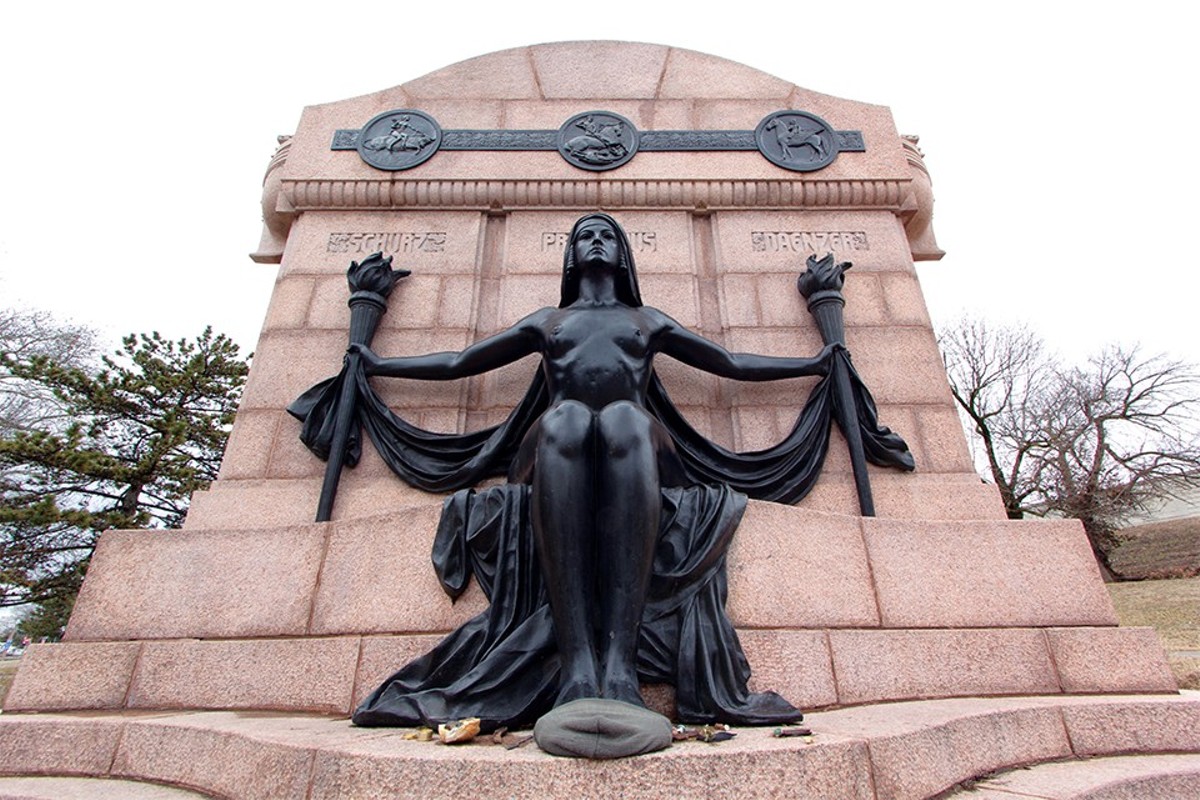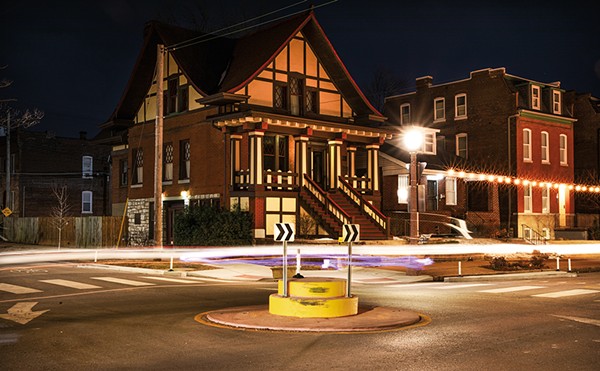A Frenchman may have founded the trading post that marked the origin of St. Louis, but it fell to a generation of German immigrants to actually build the city. The proof of that is tucked away in Compton Hill Reservoir Park, where a memorial that was built only to be quickly forgotten upon its dedication honors the men who helped create the city of their ideals.
The park today is best known for its nineteenth-century water tower — at 179 feet tall, it is difficult to miss. Restored to its former glory in 1999 by a consortium of neighborhood groups and the city, the tower is open for tours on Saturdays with a full moon from April to November. It's a popular historic site and an excellent place to walk dogs, ride your bike or go for morning stroll, thanks to its circuit of intersecting paths.
The statue remains much more obscure. If you were to happen to to walk due south of the water tower along the paved path, you'd come to a set of steps that climb a small hill. Atop this hill, and modestly screened from Grand Boulevard by a stand of trees, is The Naked Truth, a memorial statue that honors three German-American journalists who transformed St. Louis and their adopted country.
The men in question were Dr. Emil Preetorious, Carl Schurz and Carl Daenzer, and true to the contrary nature of most Germans, their monument is of a heroic female nude holding torches and seated on a large wall of pink granite. Its creation sparked outrage, controversy and that favorite pastime of the German people, lively arguments.
As later detailed by indefatigable local historian Esley Hamilton for the Society of Archaeological Historians' Missouri Valley chapter newsletter, Preetorious, Schurz and Daenzer were all part of the wave of immigrants who came to America to escape the consequences of the failed 1848 revolution of the German Confederation. St. Louis was still a small river settlement when they arrived, but the utopians soon got to work. Full of high-flown ideas about the freedom of all people, the right to public assembly, improved living and working conditions and a free press, they opened businesses, built beer empires and fought valiantly in the American Civil War (on the Union side; they were serious about that "freedom for all" bit).
Preetorious, Schurz and Daenzer all worked for various German-language newspapers in St. Louis and other American cities, but their main claim to fame locally was their (non-concurrent) service running the St. Louis Westliche Post, the premier German newspaper in America in the latter half of the nineteenth century (a young Joseph Pulitzer got his start there thanks to Schurz).
All three men died within months of each other in 1906, and the now prosperous and politically powerful German-American community sought a way to honor the lives and achievements of three of their own. They quickly struck upon the idea of a symbolic memorial.
After a round of arguments, an artist was eventually selected (Wilhelm Wandschneider, surprisingly German), and the chi-chi neighborhood of Compton Hill was designated to receive his work.
But the female nude of Wandschneider's design was a problem for many St. Louisans, including the project's main donor, Adolphus Busch. The fact that the artist had left home with typical German efficiency and was already crossing the Atlantic meant it was too late to change it, and following yet more wrangling the monument was finally finished.
German-American wealth, power and prestige were behind the work, and the technological innovation of the Compton Hill Water Tower (erected in 1898) would stand nearby as a hard-science counterpart to the artistic achievements of a generation of visionaries who were too bold and too liberal for Germany, but who raised a beautiful, thriving city in America. A city built, populated and run by proud German-Americans — The Naked Truth was essentially a tribute to themselves.
The statue was finally dedicated on May 24, 1914. Seven weeks later World War I began, and a wave of anti-German sentiment soured America, and St. Louis, of any pride in the Fatherland. The Naked Truth was quickly forgotten until it had to be moved to make way for Interstate 44. Parts of it disappeared over the next several decades after that, and it fell into a state of disrepair along with the equally neglected water tower.
But you can't keep a German down for long. The Water Tower & Park Preservation Society was founded to restore the park and its historic structures, and almost exactly 100 years after its original dedication, on May 14, 2014, The Naked Truth was rededicated. The city has changed in numerous ways since their heyday, but no doubt Preetorious, Schurz and Daenzer would be gladdened to know that newspapers still exist in St. Louis, and bemused to know that we're still arguing about the same issues. Once a German city, always a German city.






